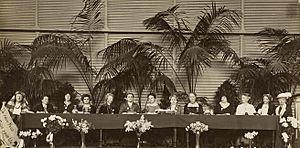Women at the Hague facts for kids
The Women at the Hague was a big meeting called the International Congress of Women. It happened in The Hague, Netherlands, in April 1915. More than 1,100 women from different countries attended. At this meeting, they created a group called the International Committee of Women for Permanent Peace (ICWPP). Jane Addams was chosen as its first president. This important meeting later led to the start of the Women's International League for Peace and Freedom (WILPF).
Contents
Why Women Met in 1915
The idea for the 1915 International Congress of Women came from two German women, Anita Augspurg and Lida Gustava Heymann. Anita Augspurg was Germany's first female lawyer. They were invited by Aletta Jacobs, a Dutch woman who believed in peace and women's rights.
The main reason for the meeting was to protest World War I, which was happening in Europe. The women also wanted to find ways to stop wars in the future.
Planning the Congress
The plan for this big meeting was first discussed in February 1915 in Amsterdam. Women from countries that were neutral (not fighting) and countries that were at war came together. They decided on a first plan for the meeting.
Dutch women were asked to organize everything and send out invitations. Women from Britain, the Netherlands, and Germany promised to pay for the meeting.
Who Was Invited to the Congress?
Invitations went out to women's groups and other organizations around the world. Each group could send two representatives. Only women could be members of the Congress.
To join, women had to agree with two main ideas:
- That countries should solve problems peacefully.
- That women should have the right to vote.
What Happened at the Congress?
The Congress started on April 28, 1915. There were 1,136 women from many different countries. They created the International Committee of Women for Permanent Peace (ICWPP). Jane Addams became its president.
The meeting followed two important rules:
- They would not discuss who was to blame for the war.
- They would not talk about rules for how wars should be fought in the future.
Challenges for Delegates
It was hard for 1,200 women to travel during wartime. For example, the British government only allowed 24 women to go from Britain. In the end, only two or three British women made it to The Hague.
Italy sent only one delegate, and she made it clear she did not represent her country. Two women from Canada also attended.
Countries Represented
Many countries sent women to the Congress. Here is a list of how many delegates came from each:
- Netherlands: 1,000
- United States: 47
- Germany: 28
- Sweden: 12
- Norway: 12
- Hungary: 9
- Denmark: 6
- Austria: 6
- Belgium: 5
- Great Britain: 3 (180 others could not come because the North Sea was closed for military reasons)
- Canada: 2
- Italy: 1
Many visitors also came to watch the Congress. The meeting was very successful. Everyone worked together well, and they passed important decisions.
Key Committee Members
Here are some of the important women who were part of the committee at the Congress:
- Austria: Leopoldine Kulka, Olga Misar
- Armenia: Lucy Thoumaian
- Belgium: Eugenie Hamer, Marguerite Sarten
- Denmark: Thora Daugaard, Clara Tybjerg
- Germany: Dr. Anita Augspurg, Lida Gustava Heymann
- Great Britain and Ireland: Chrystal Macmillan, Kathleen Courtney
- Hungary: Vilma Glücklich, Rosika Schwimmer
- Italy: Rosa Genoni
- Netherlands: Dr. Aletta Jacobs, Hanna van Biema-Hymans, Dr. Mia Boissevain
- Norway: Dr. Emily Arnesen, Louise Keilhau
- Sweden: Anna Kleman, Emma Hansson
- USA: Jane Addams, Fannie Fern Andrews, Alice Hamilton
See also
 In Spanish: Congreso Internacional de Mujeres de La Haya para niños
In Spanish: Congreso Internacional de Mujeres de La Haya para niños


